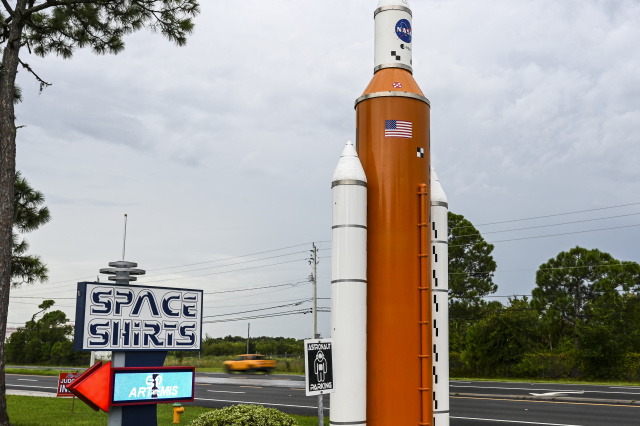NASA shoots for the Moon, on its way to Mars

A model of The Artemis I unmanned lunar rocket sits in the parking lot of the store Space Shirts, near the Kennedy Space Center in Cape Canaveral, Florida, on August 27, 2022. On the main road to Merritt Island, the peninsula where the Kennedy Space Center is located, Brenda Mulberry's space memorabilia shop is packed with tourists. Between 100,000 and 200,000 visitors are expected to attend the launch of the mission, called Artemis 1, which will propel an empty capsule to the Moon as part of a test for future crewed flights. (Photo by CHANDAN KHANNA / AFP)
(AFP) - NASA's most powerful rocket yet is set to blast off Monday on the maiden voyage of a mission to take humans back to the Moon, and eventually to Mars.
Fifty years after the last time astronauts set foot on the moon in 1972 as part of the Apollo 17 mission, the space program called Artemis is to get under way with the blast off of the uncrewed 322-foot (98-meter) Space Launch System (SLS) rocket at 8:33 am (1233 GMT) from the Kennedy Space Center in Florida.
Tens of thousands of people -- including US Vice President Kamala Harris -- are expected to gather along the beach to watch the launch, which has been decades in the making.
Hotels around Cape Canaveral are booked solid with between 100,000 and 200,000 spectators expected to attend the launch.
The goal of the flight, dubbed Artemis 1, is to test the SLS and the Orion crew capsule that sits atop the rocket.
The capsule will orbit the Moon to see if the vessel is safe for people in the near future. At some point, Artemis will see a woman and a person of color walk on the Moon for the first time.
"This mission goes with a lot of hopes and dreams of a lot of people. And we now are the Artemis generation," NASA administrator Bill Nelson said Saturday.
The massive orange-and-white rocket has been sitting on the space center's Launch Complex 39B for more than a week.
Its fuel tanks began to be filled overnight Sunday to Monday, with NASA's Exploration Ground Systems tweeting that they have been given a "go" for tanking.
But there was a brief delay of about an hour because of a high risk of lightning when the fueling operations were set to begin.
The process will continue for several hours, until the rocket is filled with more than three million liters of liquid hydrogen and oxygen.
NASA said there is an 80 percent chance of acceptable weather for a liftoff on time at the beginning of a launch window lasting two hours.
For the first time a woman -- Charlie Blackwell-Thompson -- will give the final green light for liftoff.
Women now account for 30 percent of the staff in the control room; there was just one for the Apollo 11 mission, the first time astronauts landed on the moon in 1969.
Cameras will capture every moment of the 42-day trip, including a picture of the spacecraft with the Moon and Earth in the background.
The Orion capsule will orbit around the Moon, coming within 60 miles (100 kilometers) at its closest approach and then firing its engines to get to a distance 40,000 miles beyond, a record for a spacecraft rated to carry humans.
- Extreme temperatures -
Besides the weather, any kind of technical snafu could delay the liftoff at the last minute, NASA officials have said, stressing that this is a test flight.
If the rocket is unable to take off on Monday, September 2 and 5 have been penciled in as alternative flight dates.
One of the primary objectives of the mission is to test the capsule's heat shield, which at 16 feet in diameter is the largest ever built.
On its return to the Earth's atmosphere, the heat shield will have to withstand a speed of 25,000 miles per hour and a temperature of 5,000 degrees Fahrenheit (2,760 degrees Celsius). That is half as hot as the Sun.
Dummies fitted with sensors will take the place of real crew members, recording acceleration, vibration and radiation levels.
The craft will deploy small satellites to study the lunar surface.
A complete failure would be devastating for a program that is costing $4.1 billion per launch and is already running years behind schedule.
- Life on the Moon -
Monday's launch is "not a near-term sprint, but a long-term marathon to bring the solar system and beyond into our sphere," said Bhavya Lal, NASA associate administrator for technology, policy and strategy.
The next mission, Artemis 2, will take astronauts into orbit around the Moon without landing on its surface. The crew of Artemis 3 is to land on the Moon in 2025 at the earliest.
And since humans have already visited the Moon, Artemis has its sights set on another lofty goal -- an eventual crewed mission to Mars.
The Artemis program is to establish a lasting human presence on the Moon with an orbiting space station known as Gateway and a base on the surface.
Gateway would serve as a staging and refueling station for a voyage to Mars that would take a minimum of several months.
© Agence France-Presse





